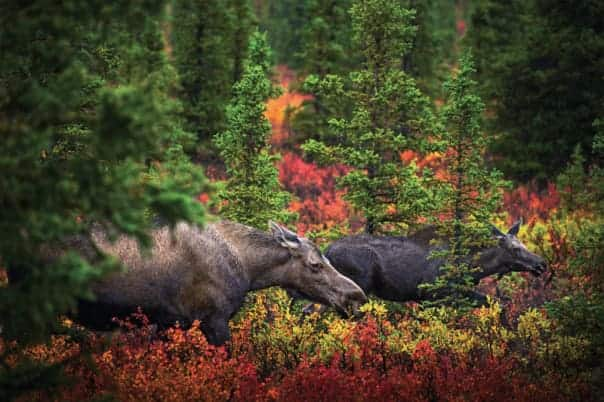Moose, Bears & Caribou, Oh My! Getting to Know ‘The Big Five’ Animals of Alaska
While the Alaska cruise season is coming to a close, we’re sure you’re already dreaming of booking your Alaska adventure for 2017. After all, Holland America Line is celebrating our 70th year in The Last Frontier next year so it’s the perfect time to go. One of the highlights of every Alaska cruise is the wildlife. Not only can you see amazing animals on shore excursions, but often you can see them from the decks of the ship – bears roaming the shoreline, whales swimming in the distance, eagles soaring over the glaciers and so much more.
Read on to learn more about The Big Five animals of Alaska in this article that was written for Holland America Line.
GETTING TO KNOW THE BIG FIVE ANIMALS OF ALASKA
Alaska is home to what is commonly known as The Big Five, which includes grizzly bears, moose, caribou, Dall sheep and gray wolves. One particular spot stands out as the best choice for seeing all five: Denali National Park. Whether hiking or on a bus tour along the Denali Park Road, the chances of viewing all five of these iconic Alaskan mammals are best at this park.
Quick facts on The Big Five animals of Alaska:
ALASKAN MOOSE
• Quite common in Alaska; moose in this state are the largest of the species.
• Habitat is typically forested areas, but increasingly they can be found in suburban areas as well.
• The largest member of the deer family. Only adult males, known as bulls, grow antlers. Some of the largest antlers can be found on Alaskan bulls.
• Moose can be intimidating creatures in the wild, standing upwards of six feet tall or more!
• Can become agitated and aggressive when disturbed. However, the greatest danger is from vehicle-borne collisions.
CARIBOU
• The only member of the deer family where both sexes grow antlers.
• In Europe they are called reindeer; only domesticated and semi-domesticated caribou are referred to as reindeer in Alaska.
• Alaskan caribou are distributed across the state in 32 herds. The Western Arctic Herd is thought to be the largest, at about 325,000 animals. The Denali Herd stays almost exclusively within the boundaries of the park and numbers around 1,700.
• Bulls (males) weigh between 350 and 400 pounds; cows (females) average between 175 and 225 pounds.
• Characterized by concave hoofs that splay outward for support on tundra and snow.
• An adult cow will typically give birth to one calf per year.
GRIZZLY BEARS
• Commonly referred to as brown bears in Alaska; the term “grizzly” is reserved for those brown bears found in the interior of Alaska.
• Adult males typically weigh up to 800 pounds with adult females weighing up to 500 pounds. Standing heights can reach as tall as seven feet!
• Distinguished by a hump at the shoulders; a flattened, dish-like face; and long claws protruding from the front paws.
• Coat color ranges from light to medium and dark brown — coastal populations tend to be of the lighter variety.
• Because the head and shoulder hair of the adult grizzly bear is often tipped white, they take on a “grizzled” appearance — hence, the name.
DALL SHEEP
• Found in high mountainous areas, Dall sheep feed and rest on ridges and slopes and use crags and rocks to hide from predators.
• Are able to seemingly defy gravity and cling to jagged, rough surfaces thanks to cloven hoofs with special padding.
• Characterized by their distinctive white coat, yellow eyes, and amber-colored horns. Males (rams) grow huge curled horns, which are used in battles to assert reproductive rights.
• Have a lifespan of between 12 and 15 years.
Named after William Dall (1845–1927), a famous Alaskan explorer and one of the founders of the National Geographic Society.
GRAY WOLVES
• Coat colors vary but gray wolves are the most common in Alaska.
• They are highly social animals that live in packs, which can range in size from a half dozen to as many as 20 or 30 animals.
• The ancestors of all domesticated dogs today, wolves typically weigh between 60 and 115 pounds.
• Wolves are carnivorous predators and scavengers. Favorite foods include moose, caribou, deer, and smaller animals like rabbits and beaver.
• Wolf pups are born blind and are quite defenseless. The pack as a whole tends to the pups until they are able to hunt, typically when they’re around 10 months old.
If you want to read the article on the Holland America Line website, click here: Getting to Know ‘The Big Five’ Animals of Alaska










its soooooooooooooooooooooooooooooooooooooooooooooooooooooooooooooooooooooooooooooooooooooooooooooooooooooooooooooooooooooooooooooooooooooooooooooooooooooooooooooooooooooooooooooooooooooooooooooooooooooooooooooooooooooooooooooooooooooooooooooooooooooo
CUTE i love bears and wolves